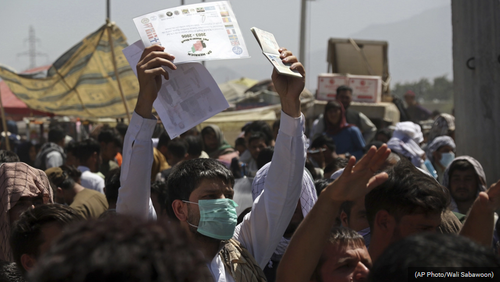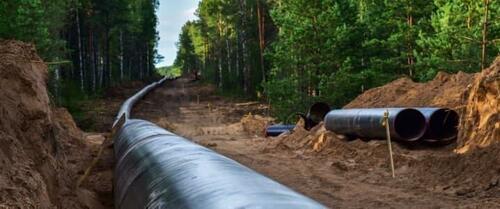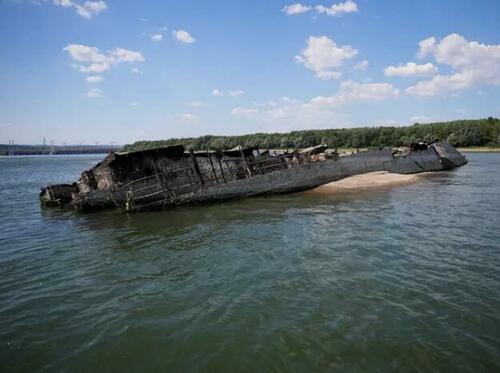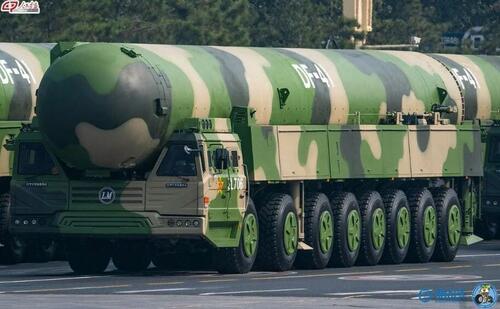Authored by Susan Crabtree via RealClear Politics (emphasis ours),
The frantic and deadly U.S. evacuation from Afghanistan was so disorganized that 1,450 children were evacuated without their parents, and senior leaders in Vice President Kamala Harris’ and first lady Jill Biden’s offices, as well as one of the Joint Chiefs of Staff, asked private veteran groups for assistance evacuating certain people from the country.

In the waning days of the evacuation, more than 1,000 women and girls waited more than 24 hours on dozens of buses, desperately circling the Kabul airport and trying to avoid Taliban checkpoints. Many of them were told multiple times they were not allowed to enter the airport. Now, nearly a year since the Taliban took control of the country, fewer than one-third of them have managed to flee the country.
These are just some of the findings in a new report by Republicans on the House Foreign Affairs Committee one year after the Taliban swept into the Afghan capital of Kabul, almost instantly rolling back more than two decades of U.S. and NATO military support and nation-building efforts.
More broadly, the report, which RealClearPolitics obtained late last week, asserts President Biden and top officials in his administration repeatedly – and perhaps intentionally – misled the American people when they said the fall of Kabul came as a surprise and there was no alternative other than depending on the Taliban for security in the Afghan capital as the U.S. military evacuated hastily.
The report asserts that the chaotic withdrawal that left more than 800 American citizens stranded in the country was completely avoidable if Biden and his national security team had listened to the warnings and advice of military leaders, U.S. diplomatic officials operating on the ground, and international allies.
It adds that one of the most tragic outcomes of the evacuation – the death of 13 U.S. servicemembers and 160 Afghans in a suicide bombing at the Kabul airport – could have been prevented if the administration had accepted the Taliban’s Aug. 15 offer for the U.S. to control the capital city’s security until the end of the withdrawal.
Such an arrangement would have allowed American forces to extend the airport’s security perimeter, creating more space for evacuating Afghans and a far more orderly process. It also would have prevented U.S. servicemembers from being penned in amid the frantic crush of Afghans desperately trying to board U.S. military planes, leaving them vulnerable to the suicide attack, several former officials told committee Republicans, according to the report.
“There were many sins if you will – there was a complete lack of and failure to plan,” Rep. Mike McCaul, the top Republican on the panel told CBS News’ Face the Nation Sunday. “There was no plan executed.”
In a new memo over the weekend, the White House started defending its decision to withdraw troops, arguing that the move strengthened U.S. national security by freeing up military and intelligence agents and assets. The memo, written by National Security Council spokesperson Adrienne Watson and first reported by Axios, is a direct response to the House Republicans’ interim report outlining their view of the administration’s withdrawal failures.
It assails the House Republicans’ report as a partisan exercise “riddled with inaccurate characterizations, cherry picked information, and false claims…. It advocates for endless war and for sending more troops to Afghanistan, and it ignores the impacts of the flawed deal that former President Trump struck with the Taliban,” the memo states.
Republicans are standing by their findings, arguing that a failure to plan left the State Department with only 36 consular officers at the airport trying to process hundreds of thousands of people in a matter of days. These officials were overwhelmed, McCaul said, but the lack of resources for a withdrawal of this magnitude was just one of the many mistakes involved in failing to plan for Kabul’s fall despite multiple warnings.
Several top U.S. military leaders for months had warned the president that the Afghan government would likely collapse if the U.S. left fewer than 2,500 troops stationed there, the report states.
The report also cites “more realistic assessments on the ground,” including a July 13, 2021, embassy cable from 23 U.S. personnel assigned to the embassy in Kabul, which reportedly contained “a stark warning” about the potential collapse of the Afghan state. The cable, which the Wall Street Journal first reported a year ago, and was sent to Secretary of State Antony Blinken and Director of Policy Planning Salman Ahmed, called on the State Department to respond more urgently to the Taliban’s offensive.
Although Blinken acknowledged the existence of the cable, he has refused to share it or disclose his response to it with congressional committees, including the House Foreign Affairs Committee.
The biggest mistake of all, McCaul argued, was Biden’s rejection of the Taliban’s offer for the U.S. to take control of Kabul’s security until the evacuation was over.
“Think about what that would have changed,” McCaul said. “We had to rely on the Taliban to secure the perimeter of [the airport], that led to the chaos, and it also led to the suicide bomber who killed 13 servicemen and women and injured hundreds of people.”
The Biden administration also rebuffed other offers that could have helped prevent the frantic crush of Afghans at the airport and preserve America’s reputation abroad, the report states. U.S. leaders ignored a proposal from Guam for the U.S. territory to serve as an interim processing center to help evacuate interpreters and other at-risk allies. It similarly declined an offer from Pakistan to have a facility there serve as a transit center for evacuees, despite other facilities in Qatar and Germany reaching capacity.
The report, which will serve as a roadmap for several lines of inquiry if Republicans win back the majority in either chamber this fall, is based on open-source information, along with interviews with U.S. officials and civilians involved in evacuating U.S. citizens and Afghan allies. Several whistleblowers who requested anonymity also played a key role, along with sworn statements by U.S. military personnel who were part of the investigation into the August 26, 2021, suicide bombing at the Kabul airport.
The State Department did not comply with requests for documents and transcribed interviews with 34 administration officials involved in the Afghanistan evacuation effort. The report also criticizes the full House Foreign Affairs Committee, led by Democratic Rep. Greg Meeks of New York, for holding just one full committee hearing with senior Biden administration officials on the Afghanistan withdrawal even though it’s widely recognized as one of the worst U.S. foreign policy failures in decades.
While the report says more State Department resources would have helped ease panic and confusion, it faults the agency for basic communication miscues that further exacerbated the chaos.
By ignoring early warnings that they were not moving quickly enough to evacuate Americans and at-risk Afghans who had worked directly with the U.S. government, they left American citizens, green-card holders, and Afghan allies approved for departure stranded outside airport gates with no assistance.
“Attempts by members of Congress and their staff to help their constituents or other would-be evacuees were often stymied by out-of-office replies to email requests and broken links to web pages mean to submit information,” according to the report.
It also criticizes U.S. Ambassador to Afghanistan Ross Wilson for going on a two-week vacation as Afghanistan was falling apart. Wilson took his summer break immediately after accompanying then-Afghanistan President Ghani to a late June meeting with Biden who promised the Afghan envoy, “We’re going to stick with you, and we’re going to do our best to see to it that you have the tools you need.”
“There were no decisions made in the embassy until [Ross] returned in mid-July. This made action impossible,” a U.S. military officer told Army investigators. “Ground could have been gained at this time if the embassy had been able to do anything.”
A couple of weeks later, it was Biden and Blinken who were on vacation at Camp David and the Hamptons, respectively, when alarms began sounding at the Pentagon for the need to relocate all of U.S. embassy personnel to the Kabul airport. Before the move, the personnel were being ordered to destroy sensitive documents in response to new fears of an immediate Taliban takeover of Kabul.
All these hasty actions left no time for the State Department to speed up the processing of immigration applications for the Afghan allies Biden had promised to protect.
There were no plans made to evacuate tens of thousands of U.S.-trained Afghan commandoes and other elite units who possess sensitive knowledge about American military operations.
Also left behind: women leaders and soldiers whom Americans had promised sanctuary, along with more than 10,000 Afghans who had been employed by Embassy Kabul since it was re-established in 2001 and thousands more who worked with U.S. Agency for International Development.
Nearly one year after the last U.S. troops left Afghanistan, the Biden administration still lacks a plan to help these at-risk Afghan allies who fought and worked alongside U.S. forces, even though the administration has admitted that the Taliban and other terrorist groups have subjected these U.S. allies to killings and forced disappearances.
And, despite Biden’s assurances that the U.S. had accomplished its original goal of expelling al Qaeda and other terrorist groups from the country, the report points to the recent U.S. strike against Ayman al Zawahiri, a top al Qaeda leader, who was living freely in downtown Kabul, as proof of the group’s presence in Afghanistan.
“Thankfully, al Zawahiri was killed by a U.S. drone strike last month, but officials warn that al Qaeda and ISIS-K continue to grow their presence in Afghanistan,” the report states.
Meanwhile, the withdrawal has wreaked havoc on the country’s economy, with some estimates that 95% of the country needs emergency assistance to avoid hunger. With the Taliban back in control, there are reports of targeted revenge killings against those who worked with the U.S. government or military. U.S.-based volunteer groups seeking to aid Afghan evacuees have reported nearly 500 reprisal attacks, including beheadings, hangings, severed limbs, lash marks, and car shootings.
The United Nations Assistance Mission in Afghanistan reported in July 2022 that these killings are often carried out “execution style – for example, when an individual is taken out of their house and shot almost immediately,” the report notes.
One of the worst casualties of the U.S. withdrawal from the country is the dramatic regression of women and girls, who are now ordered to wear burqas and are prevented from attending school or universities or even from walking unaccompanied in public places.
Child marriage is also reportedly on the rise with girls as young as nine years old being sold into marriage to pay off debts, or families being forced to marry off their young daughters to Taliban fighters, the report states, quoting PBS documentary filmmaker Ramita Navai’s comments earlier this month after two visits to Afghanistan.
The report also cites a finding by Amnesty International that “many women protesters” in Afghanistan who demonstrated against the Taliban’s repressive policies “have been subjected to arbitrary arrest and detention, enforced disappearance and torture,” including Taliban-administered beatings and electric shocks with tasers.
Although Blinken acknowledged reprisal attacks and killings earlier this year, the report points out that the secretary played down the Taliban leadership’s responsibility for the deaths.
“We are of course seeing retribution, attacks by Taliban against those who are part of the former government,” he told a House Foreign Affairs Committee hearing on April 28. “These seem to be, for the most part, not centrally directed, that is they – they tend to be happening at a local level, but they’re happening.”
Many of these allies are still sheltering in safe houses, afraid that the Taliban informants will expose their previous work with the U.S. government or NATO allies. Each passing week, they have fewer resources to purchase basic items such as food, fuel, and shelter.
With the State Department unable to aid these people, the task of clothing, feeding, and sheltering tens of thousands of Afghans has fallen to outside veteran or humanitarian groups or sympathetic individuals. With almost no support from the U.S. government, some of the personnel running these groups, many of them comprising military veterans, have drained their personal retirement accounts, quit jobs, and suspended their small businesses in order to raise the funds to operate these networks of safe houses.
“But these funds are not limitless, and the resource strains incurred have endangered the continued existence of these safe houses which many Afghans and Americans rely on for their very survival,” the report concludes.
Susan Crabtree is RealClearPolitics’ White House/national political correspondent.
















